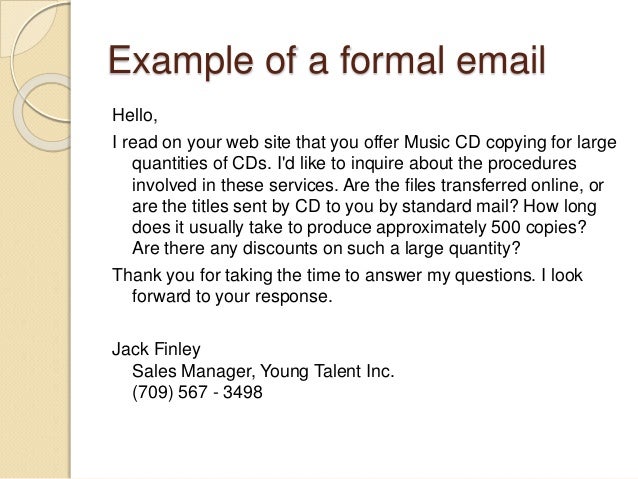English formal email examples
Let’s see how all of this works in practice. Example 1: Delay with the delivery of an order. For businesses, it usually starts with the word “Dear” followed by the name of the recipient and ends in a colon. In some letters, a comma is used after the name of the recipient.
Download our free ebook: “ Everyday English Vocabulary” – pages which points useful words and English phrases to help you have a better understanding of what’s going on around you. The examples are labelled ’ formal ’ and ’informal’- please note that most informal expressions are perfectly suitable to use in ’semi- formal ’ situations, such as between business associates who have worked together for some time and have established a good relationship.
It could make you seem friendly and make the recipient more receptive to your complaint or questions. It may seem odd to address a stranger on the Internet as Dear, but it’s standard in formal correspondence. Other respectable but less commonplace options include Greetings and Salutations.
When possible, it’s best to put the recipient’s name. I am very interested to know that whether your school has a three-week English course or just organizes a two-week course. I am writing to you because I need further information on studying English at your school. My second concern would be about the cost of the provided course.

Please note that these samples are for reference only, and we recommend you adjust them to match the tone and level of formality appropriate for a particular recipient and occasion. Follow it with a comma or colon, as in these examples : Dear Cha Dear Mr.
General Tips for Writing Emails in English 1. Because if the matter at hand is something not so important or confidential, it can always be dealt directly with the aforementioned party. You may need to write to your teacher to request a meeting with him or her. Especially when you’re trying to find a. However writing clearly and professionally is actually a skill.
And just like any other skill, you need to learn and keep on practicing to get better. Formal and Informal Email Phrases – from Greetings to Closing Phrases! Emails are one of the most widely used forms of communication, taking over from older, slower methods of conveying messages like sending a fax or writing a letter.
Then adapt them to personalize your message. Informal English : We use it with friends, children, and relatives. The following list will help you to recognize the informal and formal ways of saying the same thing.
The list is divided into sections of: verbs, transitions. This is normally reflected in the words you use to express yourself. While they use the same rules, they may have to be modified according to their purpose. Here are some examples of things you might say in a formal letter: I am writing in reply to your letter of September regarding your outstanding invoice.
Tuesday, January. I would be grateful if you could attend to this matter as soon as possible. There is a example of what a formal letter should look like. Start with a formal greeting.

The letter should start with an introductory line or two, introducing the general topic of the letter, e. I"m writing with reference to. A Sample of Informal Email Writing Format. Formal letters are different from informal letters in tone and language.
These are letters written to your bank, insurance company, landlord or employer. The name has already told us all. An important client or your boss, for example, will probably require something from the " formal " category.
But, a close colleague or long-time friend? Well, he or she might get a kick out of a. Sarah: The language that we use in informal letters is more casual and relaxed.
For example, our friends or our family members.

Yorumlar
Yorum Gönder